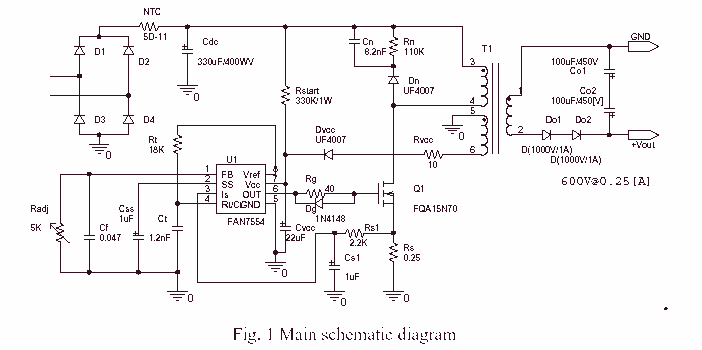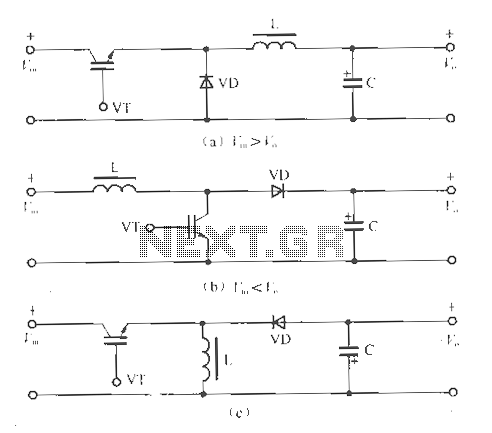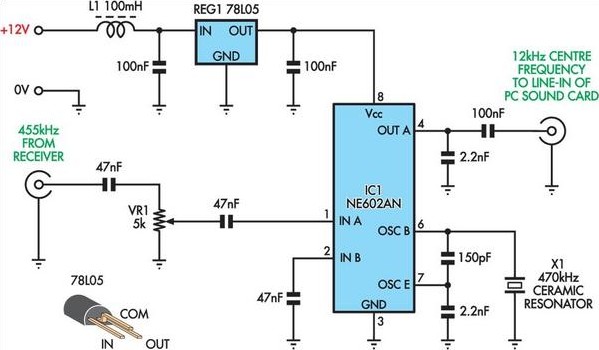
The Output Adjustable Flyback Converter

A high voltage step-up DC power supply using adjustable flyback conversion.
The circuit described is a high voltage step-up DC power supply utilizing an adjustable flyback converter topology. This design is particularly effective for applications requiring a significant increase in voltage from a lower voltage DC source. The flyback converter operates by storing energy in the magnetic field of a transformer during the "on" phase and releasing it during the "off" phase, allowing for efficient energy transfer and voltage transformation.
Key components of the flyback converter include a transformer, a switching device (typically a MOSFET), a diode, and output capacitors. The transformer is designed with a primary and secondary winding; the primary winding connects to the input DC voltage source, while the secondary winding is responsible for delivering the stepped-up output voltage.
The switching device is controlled by a pulse-width modulation (PWM) signal, which regulates the duty cycle and, consequently, the output voltage. An adjustable feedback mechanism is often implemented to maintain the desired output voltage, allowing for flexibility in applications. The feedback loop typically involves a voltage divider connected to the output, feeding back into a control circuit that adjusts the PWM signal based on the output voltage level.
The diode in the flyback converter serves as a rectifier, allowing current to flow from the transformer to the output capacitor during the off phase of the switching cycle. The output capacitor smooths the voltage output, reducing ripple and providing a stable DC voltage to the load.
Safety considerations are crucial when designing high voltage power supplies. Proper insulation, component ratings, and circuit protection mechanisms must be implemented to prevent voltage breakdown and ensure reliable operation.
Overall, this high voltage step-up DC power supply using adjustable flyback conversion presents a versatile solution for applications requiring high voltage outputs from lower voltage sources, with the added benefit of adjustable voltage levels for varying requirements.A high voltage step-up DC power supply using adjustable flyback conversion. 🔗 External reference
The circuit described is a high voltage step-up DC power supply utilizing an adjustable flyback converter topology. This design is particularly effective for applications requiring a significant increase in voltage from a lower voltage DC source. The flyback converter operates by storing energy in the magnetic field of a transformer during the "on" phase and releasing it during the "off" phase, allowing for efficient energy transfer and voltage transformation.
Key components of the flyback converter include a transformer, a switching device (typically a MOSFET), a diode, and output capacitors. The transformer is designed with a primary and secondary winding; the primary winding connects to the input DC voltage source, while the secondary winding is responsible for delivering the stepped-up output voltage.
The switching device is controlled by a pulse-width modulation (PWM) signal, which regulates the duty cycle and, consequently, the output voltage. An adjustable feedback mechanism is often implemented to maintain the desired output voltage, allowing for flexibility in applications. The feedback loop typically involves a voltage divider connected to the output, feeding back into a control circuit that adjusts the PWM signal based on the output voltage level.
The diode in the flyback converter serves as a rectifier, allowing current to flow from the transformer to the output capacitor during the off phase of the switching cycle. The output capacitor smooths the voltage output, reducing ripple and providing a stable DC voltage to the load.
Safety considerations are crucial when designing high voltage power supplies. Proper insulation, component ratings, and circuit protection mechanisms must be implemented to prevent voltage breakdown and ensure reliable operation.
Overall, this high voltage step-up DC power supply using adjustable flyback conversion presents a versatile solution for applications requiring high voltage outputs from lower voltage sources, with the added benefit of adjustable voltage levels for varying requirements.A high voltage step-up DC power supply using adjustable flyback conversion. 🔗 External reference





